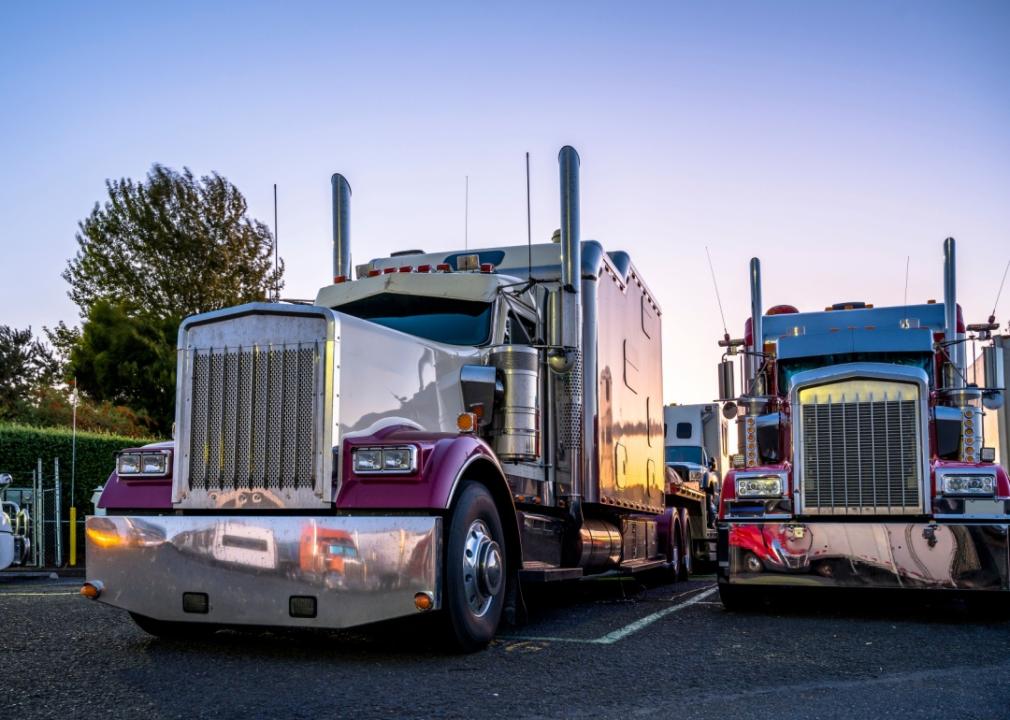Is the solution to the truck parking shortage as simple as an app?

Vitpho // Shutterstock
Is the solution to the truck parking shortage as simple as an app?
Big rig trucks stand side by side in a parking lot at sunset.
With trucks carrying more than 70% of America’s freight by weight, they’re an essential part of the nation’s transportation of goods. The long-haul drivers behind the wheel, who are responsible for getting those goods from point A to point B, are also essential. They often have grueling routes that require them to sleep in their cabs while driving cross-country—if, that is, they can find a place to park.
Confronted with strict work and rest hours regulations, many truckers, unable to find safe parking, resort to parking on the side of highways. Those who choose not to do so are forced to continue driving with the risk of fatigue and drowsiness-related accidents.
The nation’s truck parking shortage has become a severe problem, with 98% of drivers reporting difficulty in finding safe parking spots, according to the Department of Transportation. But truck parking isn’t just an industry issue. Providing ample parking for truck drivers can ease congestion, improve safety for all motorists, and help communities comply with zoning ordinances as e-commerce and the transportation of goods becomes an increasingly important part of the economy.
To help tackle parking challenges for truck drivers, Truck Parking Club compiled examples of technology solutions for safe semitruck parking in the United States.
Awareness of the shortage of truck parking was raised in 2012 by “Jason’s Law”, enacted and named in honor of a driver who was murdered while spending the night at an abandoned gas station. The law prompted a national survey and assessment for truck parking while expanding federal funding potentially devoted to truck parking. Parking issues still persist—but high-tech solutions are on the horizon.
So far, industry leaders and state transportation departments have proposed innovative solutions. Adding parking spots along busy trucking corridors such as I-90, taking advantage of existing parking infrastructure that isn’t being utilized 24/7, and using vacant land along mountain passes for truck parking are among some of the current proposals from the Washington State DOT.
![]()

Hakase 420 // Shutterstock
Technology presents real-time solutions for truckers
A trucker consults his smartphone inside his truck.
Both federal and state governments are offering grants to help researchers develop solutions for truck parking shortages. These initiatives are often driven by new technology and data-driven insights, giving commercial truck drivers greater visibility into available parking spots.
Researchers at the University of Connecticut’s Transportation Safety Research Center are developing an app to help truckers find a spot for their vehicles while they rest. The project is backed by a $1.46 million federal grant. If successful, this app could significantly reduce the number of truckers parking in unsafe conditions along the shoulder and on highway entrance and exit ramps, improving safety for all motorists.
Researchers hope the application will offer users real-time information on the availability of commercial vehicle parking through data gathered from in-ground and infrared sensors, video cameras, radar, and laser scanners.
The National Center for Sustainable Transportation at the University of California, Davis, under a DOT grant, has been working on a series of algorithms that will aid trucking industry planners with planning trips to better ensure that truck drivers are more evenly distributed across available rest areas, alleviating competition for parking.
The algorithms operate as a coordinating system, allowing planners to proceed with their choice of parking spots should supply meet demand. Should supply not meet demand, the system would use dynamic pricing to incentivize planners to opt for other low-priced parking spots, easing demand for popular parking spots and encouraging better planning.
The system relies on on-demand information from industry planners and parking availability information from parking spot managers to function.
The Center for Transportation Studies at the University of Minnesota has developed a comprehensive multiview camera-based system for assessing truck parking availability 24/7. The nonintrusive detection system is complemented by a notification infrastructure that notifies parking facility managers and other stakeholders of traffic upstream, with a reported accuracy of more than 90%. Drivers are notified of parking availability down the routes they’re traveling.
As part of the Bipartisan Infrastructure Law, the Biden administration announced in 2023 the earmarking of $80 million in grant awards toward research to mitigate issues caused by truck parking shortages.
While technology-based solutions can bridge information gaps between supply and demand, they only ease the symptoms of the problem—a lack of available parking spots in areas with high truck parking demand (such as the Northeast). Industry officials and regulators must also push for supply-side changes to finance the construction of more parking facilities.
Story editing by Alizah Salario. Additional editing by Kelly Glass. Copy editing by Tim Bruns.
This story originally appeared on Truck Parking Club and was produced and
distributed in partnership with Stacker Studio.
